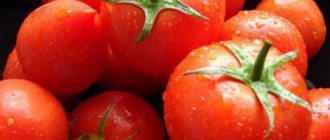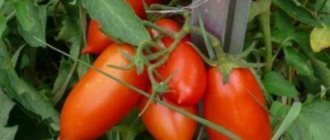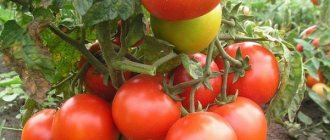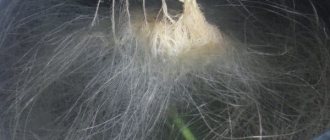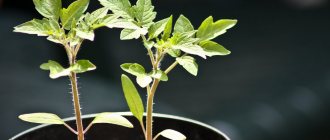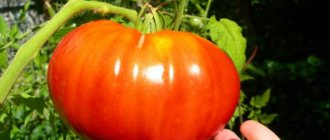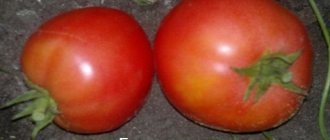The orange tomato variety Chanterelle can be called a garden exotic; it is undeservedly rare in Russian gardens. The tomato was bred agro, and has been included in the State Register since 2007. Purpose – whole fruit canning.
| Height | Landing location | Ripening time | Fruit color | Fruit size | Origin | Fruit shape |
| short | Greenhouse, Open ground | Mid-early | Orange | Average | Variety | Plum-shaped or oval |
Characteristics and description of tomato Chanterelle
The Chanterelle tomato belongs to the determinate (low-growing) varieties. The growth of the bush stops after 4–5 clusters appear. In open ground, the height of the plant is about 60 cm, in greenhouses it reaches 110 cm.
The bush is distinguished by a thin stem with medium-sized leaves of a rich green color, and has a spreading structure. The raceme is simple, with small yellow flowers, the stalk is articulated. There are 4–6 berries in a bunch.
The description of Chanterelle tomatoes indicates that this is a variety with a medium-early ripening period and a long fruiting period. The harvest lasts from mid-July to the end of August.
Detailed description of the fruits
The fruit is smooth, glossy, with a thin skin that is not prone to cracking, elongated oval (plum-shaped), dense. The section has 2–3 chambers with an average number of seeds. At technical maturity, the Chanterelle tomato variety is usually bright orange in color, but yellow and red fruits are also found. The taste is sweet, the flesh is thick. According to consumer reviews, Chanterelle tomatoes have a mild tomato taste.
Fruit length 4–5 cm, weight 100–130 g.
The presence of vitamins A, B, C, E, beta-carotene and magnesium, combined with extremely low calorie content, make this vegetable attractive for use in a healthy diet.
This variety is universal: Chanterelle tomatoes can be used as food both fresh in salads and vegetable side dishes, and canned as whole fruits. In reviews with photos about Chanterelle tomatoes you can see a variety of cooking options for this vegetable.
These tomatoes are well stored and can withstand transportation without losing their presentation, so the variety has found application on farms.
Fruiting time, yield
The declared yield of tomatoes of the Lisichka variety is 9.1 kg per 1 sq.m. Interestingly, this indicator depends little on where they are grown - in a greenhouse or in open ground. On an area of 1 sq. m plant 3-4 bushes. From the emergence of seedlings to the first harvest, it takes from 100 to 110 days, that is, when sowing seeds for seedlings in the third decade of March, the first fruits are harvested already in the second half of July. Tomatoes of the Chanterelle variety bear fruit until the end of summer.
To increase productivity, experienced vegetable growers give the following recommendations:
- selection and pre-sowing treatment of seeds must be carried out without fail;
- formation of a bush with 2 – 3 stems;
- tying and pinching;
- regular fertilizing with organic and mineral fertilizers;
- disease prevention;
- regular watering;
- mulching;
- periodic loosening and removal of weeds.
Sustainability
A distinctive feature of the Chanterelle tomato variety is its resistance to adverse weather conditions. This means that temperature changes do not have a detrimental effect even on young plants.
The variety is immune to many tomato diseases, however, like other nightshade crops, the plant is susceptible to late blight.
To prevent this common disease, you should adhere to the following recommendations:
- when planting, maintain a distance between plants of at least 30 cm;
- carry out pinching in a timely manner and remove the lower leaves;
- mulch the ground;
- water the plant at the root;
- avoid waterlogging of the soil and high humidity in the greenhouse;
- destroy (burn) plants affected by late blight;
- spray the bushes with antifungal drugs.
Advantages and disadvantages
The Chanterelle tomato variety quickly found fans among farmers and amateur vegetable growers, who appreciated it for the following characteristics:
- resistance to temperature changes, allowing the crop to be grown in the middle zone and even in the northern regions of the country;
- high productivity, both in greenhouses and in open ground;
- duration of the fruiting period;
- relative unpretentiousness;
- excellent taste and appearance of the fruit;
- versatility of use;
- high shelf life, good transportability;
- resistance to diseases and pests.
Like other varieties of tomatoes, Chanterelle has its drawbacks:
- the need to pinpoint and tie up plants;
- sensitivity to late blight.
The nuances of growing in open and closed ground
Difficulties in growing the Chanterelle variety, as a rule, do not arise even for inexperienced gardeners. But there is one caveat: to strengthen the root system of these tomatoes, it is recommended to periodically hill up the bushes.
The culture tolerates temperature fluctuations well and survives even when other tomatoes freeze.
The productivity of Chanterelle is consistently high both when cultivated in greenhouses and in open ground.
It is advisable to periodically ventilate the greenhouse premises; this will ensure an optimal microclimate. To prevent late blight, do not allow water to stagnate in the beds.
Growing rules
Growing a Chanterelle tomato does not require any special effort on the part of the gardener. However, despite its relative unpretentiousness, it, like other representatives of this culture, requires careful attention and careful care. Tomato variety Chanterelle is grown in 3 stages: forcing seedlings, transplanting into open ground or a greenhouse, subsequent care (regular watering, fertilizing, mulching, pinching, etc.).
Sowing seeds for seedlings
Sowing seeds of this variety for seedlings begins in the third decade of March, approximately 2 months before planting the crops in open ground or a greenhouse. Light soils containing sand, peat and earth are used as a substrate. To disinfect the soil, boil it with boiling water in advance. You can drive out seedlings both in common boxes and in individual containers (cups, peat pots). In this case, it will be possible to do without picking the seedlings.
Selected planting material is treated with an aqueous solution of hydrogen peroxide or potassium permanganate, and then immersed in a growth stimulator. When sowing, the seeds are buried 1 cm, well watered by drip, covered with film and left at room temperature in the light. As a rule, until the first shoots appear, the soil no longer needs watering.
If the seeds were sown in a common container, then after the second true leaf appears, the seedlings dive.
The variety's resistance to temperature changes makes it possible to avoid hardening off young plants before transplanting them to a permanent location.
Transplanting seedlings
Seedlings are planted in a greenhouse or in open ground in late spring - early summer, when warm nights set in. Compost and mineral fertilizers are added to each hole, filled with water, and only then the seedlings are carefully planted in them.
Transplanted seedlings should be immediately tied to pegs.
For 1 sq. m, no more than 4 plants are planted, following a pattern of 30x40 or 40x40 cm.
Description and characteristics of the tomato variety Chanterelle
Tomato “Lisichka” is an excellent variety for residents of the central part of the Russian Federation. This description of the variety is given by many sellers. It is a mid-early and determinate tomato variety. The main feature of this variety is its high resistance to temperature changes. This is an extremely useful quality for gardeners from regions where the weather is not always favorable for crops. The yield of the variety is quite high, although compared to others it does not stand out so much. But this is not the main feature of the variety.
Chanterelle tomatoes have very good taste. They do not have a strong tomato taste, but the sweetness of the berries differs greatly. Many note that the fruits have a very pleasant taste and are perfect for raw consumption, as well as as part of complete dishes. Tomato is a treasure trove for people who lead a healthy lifestyle. “Chantelle”, like many other tomatoes, contains a large amount of B vitamins. This variety is also rich in magnesium and vitamins A, C, E. The calorie content of the fruit is extremely low, which allows you to not worry about extra calories at all.
The performance among farmers is as good as among ordinary garden owners . They note the extreme viability of this variety, as well as ease of storage and transportation, which is very important for business owners.
How to grow
Growing the “Lisichka” tomato variety is not particularly difficult. The main feature of the variety is its painless experience of temperature changes, which are not a rare occurrence in the central zone of the Russian Federation. But despite this stability, in order to minimize losses, “Little Chanterelle” should be grown in greenhouse conditions. If you grow tomatoes in the south, you can do this outdoors.
The procedure for sowing seeds should begin two months before the intended seedlings.
When planting, it is necessary to tie up the stems of the bush, as they are quite weak and will not support the weight of the ripening fruits. It is recommended to form the plant into two or three stems (for greater yield, three stems are recommended). It is also necessary to remove side shoots, also known as stepchildren. Otherwise, the bush may not grow or produce a weak harvest.
A month after the fruit-bearing bushes have been planted, it is necessary to tear off the lower leaves. This must be done with maximum tenderness and accuracy, as thin stems may break off. It is recommended to tear one leaf at a time. The bushes need to be thoroughly watered and fed. This is necessary to avoid various diseases. The most common disease of chanterelles is late blight.
Tomato care
Almost all varieties of tomatoes need a lot of moisture. That is why the soil in the greenhouse or garden bed should not be allowed to dry out. Watering should be done regularly, using only warm water. Try to ensure that moisture does not get on the leaves and that the soil in the greenhouse does not become waterlogged. From time to time, bushes need to be treated with antifungal drugs. Loosening, weeding and mulching will be needed as necessary. For the latter, leaves, sawdust and mowed grass are suitable. A month after you plant the Chanterelle in a permanent place, the lower leaves need to be removed. To keep the fruits large and juicy, 7 clusters should be left on the stems. It is recommended to feed the plants three to four times: mineral complexes or organic fertilizers are suitable. It is extremely important to apply them during the period of flowering and fruit formation.
Reviews
Feedback from people is the best characteristic possible.
Among the comments on various resources, the following reviews can be highlighted:
- One woman planted these tomatoes and was extremely surprised that they were able to survive in open ground conditions. She grew them, but did not hope for a harvest from her planting, but despite everything, the bushes produced a fairly large number of fruits;
A farmer who was experiencing not the most successful of all his seasons said that he planted “Chanterelle” tomatoes out of despair, hoping for the veracity of reviews on the Internet. It completely met his expectations. Thanks to the presence of greenhouses, tomatoes could grow in comfortable conditions, which resulted in a very rich harvest. For him, this was the salvation of his business, and he highly recommended this variety to everyone else.
Tomato Chanterelle: variety description
High-yielding, super early (100-110 days from germination to harvest), determinate, non-standard variety of raceme tomatoes for open ground and film greenhouses, small-sized shelters. Reaches a height of 0.5-0.9 m in open ground and 1-1.5 m in greenhouses. The bushes need staking, preferably pinching and forming a bush, preferably 1 or 2 stems. But many gardeners do not form the bush, and are also satisfied with the harvest. At the seedling stage and during the period of growing green mass, the bushes seem weak, but after that they “gain strength” and surprise with an unprecedented amount of fruit. Fruits from the end of July to the end of August.
Pros and cons of the variety
In reviews of the Chanterelle tomato (in the photo you can see the fruits in cross-section), gardeners note: its resistance allows you to grow plants not only in the middle zone, but even in the northern regions of the country. Both in the open ground and in the greenhouse, equally high yields are observed. The advantages include a long period of fruiting and the unpretentiousness of the plant. In addition, the appearance and taste of tomatoes are excellent, they are distinguished by their universal use. True, it was not without its drawbacks: the Chanterelle requires timely stepsoning and tying up. Without this, the fruits will be smaller and the bushes may break off under the weight of the tomatoes.
How to plant and care
Seedlings are grown according to general rules: they are sown 60-70 days before planting in the ground, provided with heat and light, and regular watering without stagnant moisture. Once every 10-14 days you can feed with nitrogen or complex fertilizers. Picking may not be necessary if you sow one seed at a time into the cells of the seedling cassettes: the grown seedlings are then transferred to individual cups, burying the trunk into the ground to the level of the cotyledon leaves. This trick will stimulate the growth of lateral roots and the seedlings will bloom two weeks earlier. Before planting in the ground, seedlings are hardened off in the fresh air for a week.
Plant in the ground after the threat of frost has passed and night temperatures are above 16°C. The distance between bushes is 40-50 cm, between rows 70 cm for ease of plant care. It is advisable to tie up the bushes, since thin shoots will not be able to support a bountiful harvest and will fall to the ground.
It is advisable to carry out the first fertilizing with potassium humate or fermented mullein and droppings 10-12 days after planting in the ground. If there is no organic matter, feed with nitroammophoska: 2 tbsp. l. for 10 l. water and use 1 liter of solution per bush. Next, it is also advisable to feed the bushes with organic matter (fermented grass, ash, chicken droppings). Read more about feeding tomatoes here and here.
Watering is carried out once every 5-7 days, abundantly at the root. After the soil dries, loosening is carried out, which gardeners call “dry watering”. Mulching the circle around the trunk will help retain moisture longer and eliminate the need for frequent loosening and weeding.
The formation of a bush is carried out in 1-2 stems, but many gardeners say that it is better to grow a bush in 3 stems. Often stepsoning is not done if there is no time.
However, if you don’t have time to fool around with tomatoes, it’s really enough just to water them: the harvest will still be plentiful.
Agricultural technology of tomatoes
Chanterelle tomatoes are easy to care for and resistant to adverse weather conditions. Medium-sized bushes require pinching, and thin stems require garters to supports.
Transferring seedlings to open or closed ground begins in late spring or early summer, after warm weather has established and the threat of frost has disappeared.
Planting pattern – 30x40 cm, 40x40 cm. No more than four roots are placed per 1 m².
Holes for seedlings are dug to a depth of 15–20 cm and filled with boiling water.
Advice. Instead of organic matter, add 3 g of superphosphate to the wells.
Seedlings in peat pots are placed in prepared holes. The soil in plastic cups is generously moistened and the seedlings are transferred into the hole along with a lump of earth.
The bushes are immediately tied to wooden stakes.
Watering and loosening
The culture loves moisture, so it is important not to let the soil dry out. For irrigation use warm settled or rain water
Water strictly at the root, trying not to get on the leaves, once every 5-7 days.
Each time after watering, the soil is loosened. Weeding is carried out as necessary, carefully removing weeds.
Mulching the soil with sawdust, hay, peat or pine needles will help reduce the frequency of weeding.
Stepping and formation of bushes
Plants are formed into 2-3 stems, removing young shoots. The stepsons are carefully broken off by hand or cut off with a knife with a sharply sharpened blade.
A month after planting, the lower leaves are removed. No more than 7 brushes are left on each bush to increase fruiting.
Fragile stems often cannot cope with the weight of tomatoes, so they need timely garter.
Top dressing
After planting, the tomatoes are fed 3-4 times, paying special attention to the bushes during flowering and ovary formation. For this purpose, organic and complex mineral fertilizers are used.
Fertilizer application stages:
- When planting seedlings, place a handful of humus and a pinch of ash in each hole.
- Two weeks after planting - potassium-phosphorus subcortex at the rate of 1 liter per bush.
- During the flowering period - 500 ml of bird droppings, 25 g of potassium sulfate, 3 g of potassium permanganate per 10 liters of water.
- During the formation of ovaries - 2 liters of wood ash, 10 g of boric acid per 10 liters of water.
Specialized stores offer a wide selection of:
- ready-made organic fertilizers: vermicompost “Vermix”, supercompost “Pixa”, compost “Reliable”;
- complex fertilizers: diammofoska, nitroammofoska, “Kemira”, “Rastvorin”.
Important! The last two feedings are carried out without adding nitrogen. Excess of the substance accumulates in fruits, soil, and leads to poisoning of the human body
Diseases and pests
Chanterelle tomatoes are immune to verticillium and fusarium, but are susceptible to late blight. The disease can be recognized by brown spots on the leaves, fruits and stems, a whitish coating on the back of the leaves, and deformation of the fruits.
Preventative measures will help prevent infection and save the harvest:
- treatment of greenhouses with sulfur bombs;
- soil disinfection with copper sulfate;
- preventing stagnation of water in the beds and moderate watering at the root;
- removing the lower leaves;
- frequent loosening and weeding;
- mulching with peat, hay, sawdust, black agrofibre.
If infection does occur, the affected leaves, stems, and fruits are removed and burned. The tools are disinfected, the bushes are treated with the preparations “Ridomil”, “Quadris”, “Acrobat”, “Agate”, “Fundazol”. The dosage and method of preparing the working solution are indicated on the packaging.
As practice shows, Chanterelle tomatoes are most often attacked by aphids, spider mites, slugs, mole crickets and cutworms. But the whitefly is indifferent to the variety.
Modern drugs “Grom”, “Force”, “Strela”, “Fitoverm”, “Epin”, “Flumite” are effective in the fight against insects.
For those who want to grow environmentally friendly products, folk remedies for aphids, mites and cutworms are suitable:
- Infuse 200 g of onion peel in 1.5 liters of warm water. After 12 hours, add 50 g of laundry soap shavings and use to spray the bushes once a week.
- Place 3 kg of tomato tops in 10 liters of water. Boil for half an hour, strain and add water in a ratio of 1:3. Use to treat bushes 1-2 times a week.
- Boil 4 kg of wormwood in 10 liters of water for 20 minutes, cool and spray the plants once a week.
An infusion of hot pepper will help get rid of mole crickets. For 10 liters of water take 150 g of pepper and 400 ml of vinegar 9%. Leave for 24 hours and pour 500 ml of product into each hole.
They organize a night hunt for slugs - they collect the pest by hand or spray the bushes with a solution of ammonia (4 tablespoons per 10 liters of water).
Advice. Plant marigolds, fragrant dill, chamomile, fennel or mint near the tomato beds. This will attract ladybugs - faithful helpers in the fight against aphids.
Reviews from gardeners
Polina Medvedeva, Volgograd
My Chanterelle tomatoes are one of those “must be planted” tomatoes. I’ll explain why: in rainy, cold summers they simply save me, and in general, in any weather they can withstand both heat and cold dampness. The harvest is always plentiful and the taste is excellent. You just need to wait until they are fully ripe for the tomatoes to be tasty and sweet - they should have a deep orange color. Well, you can put slightly unripe ones in a jar. They are some of the most beloved ones when preserved: they have an unusual color and shape, they are tasty, they are always intact, and the skin does not crack. I rarely use it for juice (only to collect seeds), more often with other varieties so that the color is beautiful.
Natalia Korovaeva, Kamensk-Shakhtinsky
A friend gave Chanterelle tomatoes as seedlings and highly praised them. Indeed, I was also satisfied. I didn’t notice any difficulties in caring for it; I had to tie it up. But I’m so used to it, I tie up all the tomatoes so that they don’t get dirty. They watered when there was time, often even only on weekends, but the harvest was pleasing, so they closed it and ate it. Tomatoes are dense, good to take with you on the road. We will plant more.
Evgenia Prikhodko, Old Poltavka
My bushes are not tall, maybe because I don’t pamper them, only half a meter. And I’m not tying it up. I water it a couple of times a week, I don’t feed it. Chanterelle has been producing good harvests for several years now. And I really like the tomatoes themselves because of their fleshy flesh, just oily, and delicate sweetish taste. Oh, how good they are when preserved! The tomatoes are very early, the first to hit the table. The color is also amazing!
Reviews about Chanterelle
Summer residents claim that tomatoes of this variety are one of the best for canning. Firstly, they are beautiful, secondly, they are tasty, and thirdly, they fit perfectly into jars and do not crack. The blanks turn out surprisingly elegant. The ability of the variety to adapt even to the most unfavorable weather conditions is also pleasing. And the high yield and excellent taste are the reason that Chanterelle has earned the recognition of amateur vegetable growers and experienced farmers.
photo author Evgeny Balashov
Tomato Chanterelle
The Chanterelle tomato is one of the few varieties that can grow and form in open ground in the northern zone of the Russian Federation. This variety has gained great popularity among agricultural technicians who live in central Russia and its north. The variety was bred with the expectation that it would not be susceptible to low air temperatures and frost on the soil. The productivity of this variety is high. But in order to achieve it, you must follow the rules of caring for this crop. According to the characteristics and description of the variety, the Chanterelle tomato has a good vitamin composition, thanks to which the fruits are valued not only by agricultural technicians, but also by those who only eat tomatoes. This variety has a high content of magnesium and B vitamins.
Characteristics and features of the variety
Tomato Little Fox characteristics and description of the variety indicate that this is an early ripening tomato. The description of the Lisichka tomato variety indicates that it can be grown in open ground even in central Russia. It will also take root in the northern zone, but it will need to be grown under film or agrofibre. The crop is classified as determinant (the height of the main stem is limited). It reaches a height of no more than 110 cm. The stems are not thick, the leaves are medium in size and rich green in color. The inflorescences are simple, the stalk has an articulation.
The fruits are oval, ovoid, slightly elongated. When ripe they are green in color, like most other varieties. During ripening they become a rich orange color. Chanterelle tomatoes have a smooth surface and thin skin. The tomato is not prone to cracking. The pulp is sugary, not watery, with a pronounced sweet taste and aroma. The Chanterelle tomato has no more than 3 chambers containing seeds. The weight of a mature fruit is about 140 g.
Appearance
The bush is small in size, from eighty to ninety centimeters in height. The leaves are small and dark green in color. The fruits themselves have an elongated shape, which in many ways resembles a plum. They come in yellow or orange, but red tomatoes are also available. The fruits are small in size. Each individually weighs approximately 100-150 grams. The pulp of the fruit is fleshy and dense, containing an average number of seeds. The stems are quite thin.
See also
Description of the tomato variety Slavyanin, features of cultivation and careRead
Planting and growing the tomato variety Chanterelle
The Chanterelle tomato is unpretentious to either watering or fertilizing. Therefore, growing it yourself will not be difficult even for a beginner. The main positive property of this variety is that it is very resistant to sub-zero temperatures. Therefore, despite the weather conditions, it can be safely planted in any convenient place on the site.
Seeds for seedlings are planted 60 days before planting in open ground. Seeds should be soaked briefly in hydrogen peroxide before planting. After this, you can soak them in any growth stimulator for a day. Next, the seeds are sown in cups filled with soil, especially for seedlings. It can be bought at any store specializing in agricultural crops. Seeds planted in the ground are watered with a small amount of water at room temperature. Containers with planted seeds are covered with a transparent film, creating a greenhouse effect. The film can be removed when the first shoots emerge.
Note! If several sprouts have sprouted in one glass, they need to be planted. This will allow the root system of each plant to be stronger.
After 55-60 days, the seedlings can be planted in open ground. You need to carefully transfer the sprouts into the holes so as not to damage the roots of the plant. Despite the fact that the variety is quite resistant to low temperatures, it is advisable to ensure that there is no significant negative impact on the soil for several days after planting. This is necessary so that the plant can adapt to new conditions.
The holes also need to be prepared before planting seedlings. Mineral fertilizers and compost are added there. Then they fill it with water and only then plant the plant. If the seedlings were planted in peat cups, then they can be planted directly in them without disturbing the root system.
Growing the plant involves constant hilling of tomato bushes. This is necessary so that new roots can develop. Also, after each watering, the soil must be loosened so that air and moisture can freely penetrate to the root system. Weeds must be removed between the bushes; this is a good preventative measure for fungal diseases.
During the ovary period, plants should be fed with fertilizers: mineral and organic. The composition of the mineral fertilizer should change along with the growth of the bushes. If you follow the conditions for proper care of the bush, flowering and ripening of this tomato variety, you can achieve a good harvest.
Important! Excess shoots of this variety of tomato should be removed in order for the yield to be even higher. A month after the seedlings have been planted in open ground, it is recommended to tear off several lower leaves from the bush.
The agricultural technician must carefully carry out all these manipulations, since the stems of this variety are very thin and can break if handled carelessly. In order not to flood the bushes and not to dry out the soil, it must be mulched. Any material is suitable for this:

